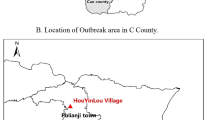Abstract
Five cases of cutaneous anthrax among children have been reported. Except one child who was 9-year old, all contracted the disease between 7 months to 1 year of age. The disease was characterized by a solitary painless charcoal-black eschar surrounded by nonpitting massive oedema. In one case, the infection was transmitted from mother to her 7 month old infant which appears to be the second report of mother-to-child mode of spread of anthrax. The response to benzyl penicillin was dramatic in four cases but a 10 month old boy with malignant pustule on the nape of neck died due to upper airway compression because of massive regional oedema. It is emphasized that the clinical picture of cutaneous anthrax is so characteristic that the diagnosis can be made without laboratory support.
Similar content being viewed by others
References
Lamb R: Anthrax. Br Med J 1: 157, 1973
Ramsay H, Emond R: Infectious diseases. W. Meinemann Medical Books, London 1267
Brachman PS: AnthraxIn Infectious diseases, Moeprich PD, Ed. Marper and Row, Hagerstown Md p 757, 1972
Borts IN: AnthraxIn communicable and Infectious Diseases, 7th ed. Top FN and Wehrle PF, Eds. C.V. Mosby, St. Louis, 108, 1972
Tahernia AC: Treatment of anthrax in children. Arch Dis Child 42: 181, 1967
Tahernia AC, Nashemi C: Survival in anthrax meningitis. Paediatr 50: 329 1972
Manios S, Kavaliotis I: Anthrax in children. A long forgotten potentially fatal infection. Scand J Infect Dis 11: 202, 1979
Epidemiology: Anthrax. Br Med J 1: 764, 1970
Epidemiology: Anthrax. Br Med J2: 598, 1971
Taylor L, Carslaw RW; Cutaneous anthrax, Lancet 2: 1214, 1967
Taaffe A: Anthrax—A review. J Irish Med Assoc 72: 437, 1979
Gold H: Anthrax. A report of one hundred and seventeen cases. Arch Intern Med 96: 387, 1963
Anthrax. Practitioner 191: 588, 1963
Stein CD; Anthrax,In Diseases transmitted from animals to man. 5th ed. Hull TG, Ed. Charles C. Thomas, Springfield, IU, 82, 1963
Farinas EC: The last anthrax outbreak in La Union Luzon, Philippine Islands.In Symposium on anthrax in man, Hospital of the University of Pennsylvania, 13, 1954
Meneghini C, Lospalluti M, Angelini G: Berufsdermatosen 22: 233, 1974
Cluff LE:In Harrison’s Principles of Internal Medicine 9th ed. Mcgraw-Hill Book Company, 1980
Infectious diseases. Epidemiology and Practice. Livingstone, Edinburgh 1974
Topley WWC, Wilson GS: Principles of bacteriology and immunology. Edinburgh 1974
Amidl S, Dutz H. Kohout E, Ronoghy A: Tropenmedizin Und Parasitologie 25: 96, 1974
Seven M; A fatal case of pulmonary authrax. Br Med J 1: 748, 1976
Anthrax. Current Paediatric Diagnosis and Treatment, 4th ed. Lange Medical Publication, 1976.
Author information
Authors and Affiliations
Rights and permissions
About this article
Cite this article
Arya, L.S., Saidali, A., Qureshi, M.A. et al. Anthrax in infants and children in Afghanistan. Indian J Pediatr 49, 529–534 (1982). https://doi.org/10.1007/BF02834559
Issue Date:
DOI: https://doi.org/10.1007/BF02834559




